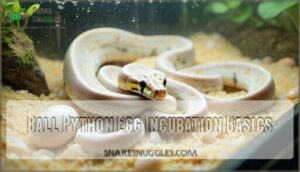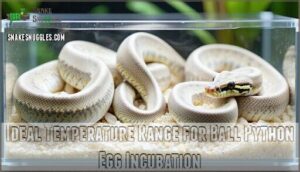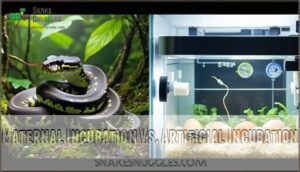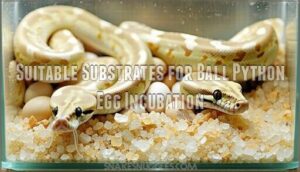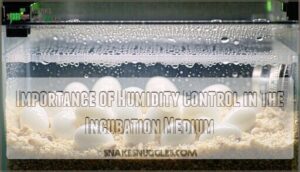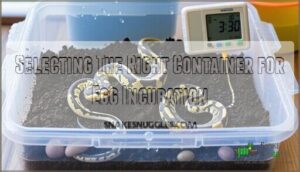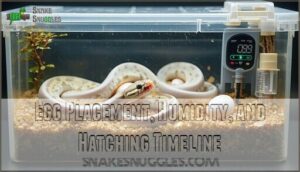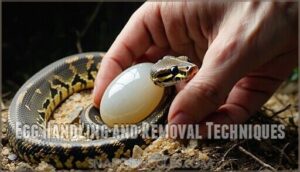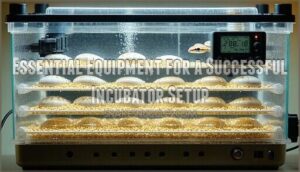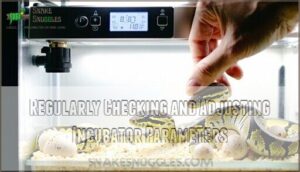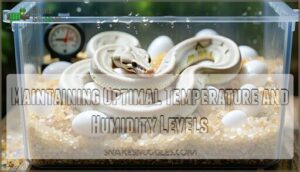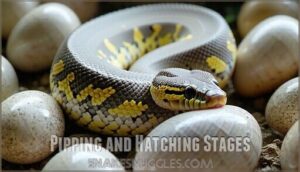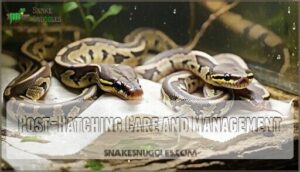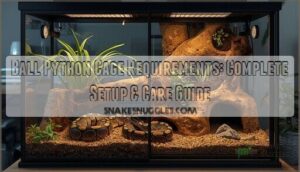This site is supported by our readers. We may earn a commission, at no cost to you, if you purchase through links.
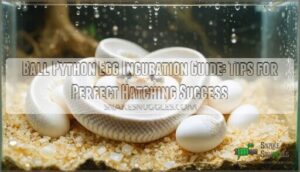
Set your incubator to 88-90°F and aim for 90-100% humidity.
Use an incubation medium like vermiculite or perlite, mixing it with water at a 1:1 ratio by weight.
Place eggs gently in a secure container, avoiding rotation to protect embryos.
Monitor the setup regularly—fluctuations in temperature or drying out can harm the eggs.
Most ball python eggs hatch after 55-60 days, so patience is key.
Keep an eye on them and, when hatching starts, resist the urge to help too soon.
A steady setup guarantees your hatchlings thrive and ensures a successful hatch.
Table Of Contents
- Key Takeaways
- Ball Python Egg Incubation Basics
- Ideal Temperature Range for Ball Python Egg Incubation
- Maternal Incubation Vs. Artificial Incubation
- Incubation Medium and Container Requirements
- Egg Placement, Humidity, and Hatching Timeline
- Egg Handling and Removal Techniques
- Incubator Setup and Monitoring Best Practices
- Egg Candling and Monitoring Development
- Pipping and Hatching Stages
- Post-Hatching Care and Management
- Frequently Asked Questions (FAQs)
- Can I let my ball python incubate her own eggs?
- What temperature do ball python eggs hatch at?
- How long do Ball Python Eggs incubate?
- How do ball pythons incubate?
- What temperature do you incubate Ball Python eggs?
- Can a ball python incubate her own eggs?
- How long do you incubate ball python eggs?
- What humidity should ball python eggs be incubated at?
- Can you incubate ball python eggs at 87 degrees?
- What can I use to incubate snake eggs?
- Conclusion
Key Takeaways
- Set your incubator temperature to 88-90°F and maintain humidity levels at 90-100% to create the ideal environment for ball python eggs.
- Use vermiculite or perlite as a substrate, mix it with water at a 1:1 ratio by weight, and avoid rotating the eggs during placement.
- Monitor temperature fluctuations and humidity daily to avoid harmful fluctuations and ensure a consistent setup for egg development.
- Expect eggs to hatch in 55-60 days; stay patient and avoid helping hatchlings unless needed to ensure safe emergence.
Ball Python Egg Incubation Basics
Incubating ball python eggs successfully requires careful attention to temperature, humidity, and stability.
Careful temperature, humidity, and stability are the keys to successfully hatching healthy ball python eggs every time.
By providing the right conditions, you can guarantee healthy development and improve the chances of a successful hatch.
Essential Supplies and Setup
Starting a ball python incubation setup requires specific gear. Begin with a reliable incubator and a thermometers/hygrometer combo for accuracy.
Choose an egg box that snugly contains 6–10 eggs.
- Substrate Options: Use vermiculite or perlite for moisture retention.
- Humidity Control: Maintain proper airflow and humidity levels.
- Egg Boxes: Guarantee airtight sealing for ideal hatching conditions.
A reliable setup starts with a quality reptile incubator.
Incubator Types and Temperature Control
When choosing incubator types for ball python eggs, focus on precision and ease. Commercial options suit beginners, while DIY incubators offer customization.
Temperature stability is critical—fluctuations harm embryos. Look for digital monitoring to track temperature and humidity accurately, and verify proper air circulation.
A stable environment with a proper temperature gradient supports healthy development.
- Commercial Options: Beginner-friendly, reliable
- DIY Incubators: Customizable for exact needs
- Temperature Control: Vital for healthy development
Maintaining Optimal Temperature and Humidity
Maintaining the right temperature and humidity is like balancing a seesaw—it’s essential for ball python egg incubation.
Maintaining temperature and humidity is a delicate dance, the cornerstone of successful ball python egg incubation and healthy hatchlings.
Aim for consistent temperature stability between 88-92℉ and keep humidity monitoring at 80-100%.
Fluctuations in the environment can invite incubation risks like embryo death, so don’t leave it to chance.
Regularly check and calibrate your equipment. Good temperature control and equipment calibration are critical.
Avoid overhandling eggs; just guarantee the incubator stays stable.
Proper environmental factors, including ventilation, keep eggs safe and ready for healthy hatching.
Ideal Temperature Range for Ball Python Egg Incubation
You need to keep the temperature between 88°F and 92°F to guarantee healthy ball python embryos develop and hatch successfully.
Even slight fluctuations outside this range can impact their survival or cause deformities, so precise monitoring is essential.
Understanding The Importance of Temperature Stability
Keeping ball python eggs at a stable temperature isn’t just a preference—it’s the backbone of incubation success.
Even slight temperature fluctuations can harm hatch rates or lead to development abnormalities.
Always monitor and calibrate your incubator carefully to maintain consistency.
- Stick to 88-92°F for ideal results.
- Perform regular thermostat calibration.
- Use a consistent and reliable heat source.
- Monitor temperature daily to spot issues early.
- Avoid sudden changes that jeopardize the eggs’ development, ensuring stable conditions for successful hatch rates.
Factors Affecting Temperature Control in The Incubator
Stable temperatures are essential for egg incubation.
Ambient temperature changes? Prevent them with smart incubator placement in a steady environment.
Power outages or equipment malfunctions can disrupt the incubator setup—always have backups ready.
Reliable air circulation guarantees even heat throughout the egg incubation box.
Monitoring humidity for eggs alongside the temperature for eggs keeps everything balanced for successful hatching, ensuring a stable and reliable air circulation.
Maternal Incubation Vs. Artificial Incubation
In the context of ball python egg incubation, you can choose between letting the mother do the work or using an incubator.
Each method has its own requirements, benefits, and challenges that can affect hatching success.
Advantages and Disadvantages of Maternal Incubation
Maternal incubation is a natural incubation method where female ball pythons manage their eggs’ temperature and humidity by coiling around them.
While this reduces egg handling and supports maternal care instincts, it has drawbacks like maternal risks and less environmental control.
A well-prepared mother improves hatchling success, but challenges such as health concerns and fluctuating conditions remain.
| Pros | Cons | Considerations |
|---|---|---|
| Natural incubation | Maternal risks like stress | Monitor female health closely |
| Minimal equipment | Poor environmental control potential | Verify high humidity stability |
| Instinct-driven care | Hatch rates can vary from artificial setups | Test conditions for consistency |
Advantages and Disadvantages of Artificial Incubation
Artificial incubation gives you control, consistency, and better hatch rates.
With temperature precision at 88-90°F and humidity control, it maximizes success.
While it’s pricier upfront, you avoid surprises like fluctuating environmental conditions.
Imagine being the pilot of a perfectly tuned plane—it’s all smooth sailing.
Plus, egg cutting becomes easier when needed.
However, this method requires space, careful monitoring, and equipment.
Balancing cost with effort is key to creating a stable incubation environment for ball python egg incubation.
| Feature | Pro | Con |
|---|---|---|
| Temperature | Precise control guarantees success | Requires constant monitoring |
| Humidity | Adjustable, prevents egg drying | Needs specialized equipment |
| Hatch Rates | Higher with consistent conditions | Costly initial setup |
| Space Needs | Compact setups available | Can occupy significant room space |
Choosing The Right Method for Your Ball Python
Choosing between maternal and arternal incubation depends on your needs and experience.
Maternal pros include instinctive warmth and protection, but you lose control of the incubation environment. Artificial methods guarantee precise temperature and humidity control but demand incubation equipment and expertise.
A hybrid approach can work for beginners balancing budget concerns.
Here’s a breakdown:
| Factor | Maternal | Artificial |
|---|---|---|
| Control | Limited | High |
| Equipment Needed | None | Essential |
| Success Rate | Variable | Reliable |
| Beginner Method | Challenging | More Practical |
Incubation Medium and Container Requirements
You need a container that’s secure and keeps humidity levels consistent to give your ball python eggs the best chance at hatching.
Use a proper incubation medium, like vermiculite or perlite, to support moisture retention without soaking the eggs, and ensure it maintains the required humidity levels for successful hatching.
Suitable Substrates for Ball Python Egg Incubation
Regarding ball python egg incubation, selecting the right substrate is key for maintaining proper moisture and preventing mold.
- Vermiculite vs. Perlite: Vermiculite keeps moisture longer; Perlite guarantees clean, airy conditions.
- Substrate Moisture Levels: Damp, not soggy.
- Substrate Depth: Eggs should be half-buried for stability.
- Mold Prevention: Regularly check for growth.
- Reusing Substrates: Avoid—fresh materials work best for humidity control.
Many breeders source ball python vermiculite for prime incubation.
Importance of Humidity Control in The Incubation Medium
Humidity control is vital for keeping ball python eggs healthy during incubation.
The right balance guarantees proper egg hydration, preventing mold while supporting development.
Too little humidity dries out the incubation medium, while too much encourages fungus.
Using a moisture-retentive substrate like vermiculite helps stabilize substrate moisture, enhancing the hatch rate.
Regular monitoring and occasional ventilation guarantee fresh airflow and balance egg humidity.
Keep conditions steady, and you’ll provide a safe, thriving environment for the delicate incubation process.
Selecting The Right Container for Egg Incubation
Selecting the right container for python egg incubation is all about functionality and reliability.
Your egg box setup must meet these requirements:
- Size Matters: Pick a container large enough to house the eggs and a damp substrate but small enough to maintain stable conditions.
- Container Material: Choose plastic or sealed containers that retain humidity without trapping condensation.
- Ventilation Needs: Add small, even-spaced holes to guarantee steady airflow and prevent mold growth.
For specialized needs, consider an egg incubation container designed for reptiles.
Sterilization methods and a simple cost analysis can also help guarantee your egg incubation setup stays clean and effective.
Egg Placement, Humidity, and Hatching Timeline
When incubating ball python eggs, you’ll need to carefully place them in a stable position to guarantee proper development.
Maintaining high humidity and understanding the 55-60 day hatching timeline are vital for a successful and healthy outcome.
Proper Egg Placement in The Incubator
Start with careful initial placement—lay each egg in damp vermiculite, burying it just ⅓-½ deep for stability.
Pay attention to egg orientation, keeping the top side up as laid.
For proper egg separation, space them apart to prevent issues like molding or clustering.
Avoid covering them entirely to allow for good air exposure.
With 2-3 inches of substrate, your incubator egg placement will support healthy ball python egg incubation.
Maintaining Optimal Humidity Levels
Keeping humidity levels steady is critical for healthy eggs. Aim for 80-100% humidity using a hygrometer to monitor conditions.
Avoid condensation build-up by fine-tuning moisture levels. Check your substrate regularly to prevent drying out or mold issues.
- Mix vermiculite with water until slightly damp, not wet.
- Monitor incubator humidity control closely.
- Watch for egg desiccation prevention signs diligently.
Understanding The Hatching Timeline for Ball Python Eggs
When incubating ball python eggs, expect the hatching process to take 55–60 days, though timeline variations depend on consistent temperature and humidity.
Use egg candling to monitor development and watch for sinking shells—a sign of the hatching process starting.
Delayed hatching may require patience, while careful hatching assistance guarantees safety.
After hatching, follow the post-hatch timeline for care.
Egg Handling and Removal Techniques
When removing ball python eggs, handle them gently to avoid harming the delicate embryos. Carefully mark the top side for orientation and transfer them without rotating to guarantee proper development.
Minimizing Stress and Disturbance During Egg Removal
Handling ball python eggs needs a steady hand and careful planning.
Observe the female’s behavior; act when she’s relaxed.
Follow these steps to guarantee smooth and stress-free egg removal:
- Wait for the female to calm down.
- Use gentle removal, minimizing movement.
- Carefully move eggs while marking them.
- Avoid disrupting the nesting area further.
- Prioritize egg safety during handling.
Proper Techniques for Removing Eggs From The Female
When removing ball python eggs, prioritize female safety and stress reduction for a smooth process. Gently loosen the female’s grip on the nesting box without causing harm.
Handle eggs with care to guarantee egg safety, avoiding any shifts in orientation. Use deliberate, gentle movements.
- Support eggs underneath during transfer to maintain their integrity.
- Work efficiently, but don’t rush, as careful egg handling matters.
Use a clean, soft surface for temporary placement before moving eggs to the incubator. To prevent contamination, consider using sterile incubation mediums.
Marking and Orienting The Eggs for Artificial Incubation
When moving eggs for artificial incubation, care is everything. Gently handle each egg, avoiding rotation to protect embryos.
Use a non-toxic pencil to mark an “X” on the top of each one—this keeps orientation consistent throughout incubation.
Proper egg orientation guarantees embryos stay safe and develop normally. If eggs are stuck together, separate them only when necessary to reduce risks.
Candling helps check fertility and monitor development. These marking methods and handling precautions boost your chances of success while maintaining each egg’s viability and health.
Incubator Setup and Monitoring Best Practices
Setting up your incubator correctly guarantees your ball python eggs stay in the perfect conditions for hatching.
Regular monitoring of temperature and humidity is essential to prevent fluctuations that could harm the developing embryos, ensuring the perfect conditions are maintained.
Essential Equipment for a Successful Incubator Setup
Setting up an incubator for ball python egg incubation starts with reliable equipment. First, select the right incubator type—commercial incubators are user-friendly, but DIY options offer more control.
Use racking systems to secure eggs, and cushion them with a damp substrate like vermiculite or perlite. Digital thermometers are non-negotiable for monitoring steady temperatures, while humidity control tools, like hygrometers and misting systems, guarantee the 88-92°F and 95-99% balance needed.
Good ventilation keeps air fresh. To maintain proper moisture, consider using perlite or vermiculite. For added security, invest in a backup power source to handle outages.
Every tool works together to create the ideal environment, giving your eggs their healthiest start.
Regularly Checking and Adjusting Incubator Parameters
Monitoring your incubator is key to successful ball python egg incubation.
Regular checks help you catch issues like temperature fluctuations or humidity imbalances before they harm the developing eggs. Use reliable tools for accurate incubation monitoring and make adjustments promptly.
- Calibrate equipment regularly to guarantee accurate readings.
- Monitor daily for temperature fluctuations and humidity adjustments.
- Inspect vents to guarantee proper airflow and prevent mold formation.
- Record all readings to track changes over time.
- Adjust settings immediately if any inconsistency arises.
Consistency in these practices guarantees ideal egg temperature and humidity control, promoting healthy hatching.
Maintaining Optimal Temperature and Humidity Levels
Creating the right balance of temperature and humidity is essential for ball python egg incubation.
Keep incubation temperature at 88-92°F and maintain humidity at 80-100%.
Regularly calibrate equipment, monitor moisture levels, and address condensation to optimize environmental factors.
Check this handy table for clarity:
| Factor | Ideal Range |
|---|---|
| Temperature | 88-92°F |
| Humidity Level | 80-100% |
| Substrate Moisture | Consistent |
This guarantees healthy eggs!
Egg Candling and Monitoring Development
Candling your ball python eggs is an essential step to track their development and guarantee they’re progressing healthily.
By carefully shining a light through each egg, you can monitor the growing embryo and identify any potential issues early, which is crucial for ensuring the development of the eggs.
Benefits of Egg Candling During Incubation
How can candling python eggs take your incubation game to the next level?
Egg candling lets you assess egg viability by spotting key details like blood vessels early on.
This is essential for fertility identification and gives insight into potential issues.
By tracking egg development regularly, you can monitor progress and make adjustments if something seems off.
It’s also invaluable for hatching prediction, helping you anticipate key moments.
Think of it as your window into the unseen world of developing baby snakes!
Observing Embryo Development Through Egg Candling
Turn off the lights and start the candling process to witness egg development.
You’ll observe:
- Blood vessels forming intricate patterns as vein development progresses.
- Embryo movement, showcasing healthy development.
- Clarity of veins, marking key growth stages.
- Abnormalities detection, signaling potential concerns early.
Keep an eye on candling frequency—it’s your best tool for monitoring embryo development and the eggs’ overall health.
Identifying Potential Issues or Infertile Eggs
Spotting issues early guarantees successful incubation.
Look for signs like vein absence, which indicates infertile python eggs often called slugs.
Egg discoloration, egg collapse, or odor detection may signal python egg abnormalities like rot.
If you notice mold growth on python eggs, gently remove it with a Q-tip.
Regular candling helps confirm egg fertility.
Address problems quickly to prevent harm.
Healthy eggs show branching veins; absent veins or unusual textures suggest infertility or trouble.
Pipping and Hatching Stages
As the hatching process begins, you’ll notice small slits appear on the eggs, a sign that the hatchlings are using their egg tooth to pip.
Monitoring closely during this stage guarantees you can address any complications and help create a safe environment for the emerging snakes.
Explanation of The Pipping and Hatching Process
As incubation nears completion, hatchling ball pythons begin the pipping process, using their egg tooth to crack the shell.
This gradual emergence can take hours or even days. Temperature and incubation length affect emergence timing and success.
- Hatching Assistance: Only help if absolutely necessary.
- Signs to Watch: Egg dimpling and slits.
- Patience: Hatching naturally takes time.
- Post-Hatch Care: Be ready for newborn needs.
Observing and Assisting The Hatchling Ball Pythons
How can you support hatching ball pythons? Monitor hatchlings carefully as they use their egg tooth to emerge.
Keep the enclosure setup warm and humid to guarantee hatchling survival.
Focus on post-hatch care:
- Observe emergence progress: Gently assist if needed.
- Check for a smooth first shed: A healthy start.
- Watch early feeding habits: Guarantee baby ball pythons eat promptly.
Ensuring a Successful and Safe Hatching Experience
Carefully overseeing hatching guarantees hatchling health and supports a safe environment for your ball python eggs. Patience is key—eggs hatch on their timeline, often over several days.
Avoid cutting unless necessary, as it carries cutting risks. Follow egg incubation guidelines diligently for best results. Monitor pipping daily and check the egg incubation environment.
After hatching, focus on post-hatch environment stability to support the first shed and guarantee healthy development. Remember that hatchlings need proper humidity levels to avoid shedding issues.
| Aspect | Do | Don’t |
|---|---|---|
| Pipping Monitoring | Observe daily for progress | Interrupt the process |
| Cutting | Assist weak hatchlings post-pipping | Cut too early or unnecessarily |
| Post-Hatch Care | Stabilize temperature and humidity | Neglect environmental consistency |
| Health Checks | Guarantee safe first shed conditions | Skip regular wellness observations |
Post-Hatching Care and Management
Once your hatchlings emerge, you’ll need to provide a warm, humid environment to support their development.
Ensuring proper feeding and addressing potential health concerns early on will set them up for a healthy start.
Temperature and Humidity Requirements for Newborn Ball Pythons
A proper enclosure setup is vital for hatchling care. Maintain a stable temperature gradient of 80-85°F and verify newborn humidity stays at 50-60% for their first shed.
Use these tips for perfect conditions:
- Use an under-tank heater with a reliable thermostat.
- Place a thermometer at both ends of the habitat.
- Include a moist hide for humidity maintenance.
- Avoid substrates that hold too much water.
- Check frequently for proper levels with a hygrometer.
Feeding and Nutrition Recommendations for Hatchlings
For your ball python’s first meal, offer prey properly sized—no bigger than the python’s widest point.
Stick with small, live, or thawed mice. Follow a feeding schedule every 5-7 days to establish a routine.
Occasionally sprinkle calcium or vitamin powder for dietary balance, addressing supplementation needs.
Make certain a dish of fresh water is available for hydration methods, as hydration supports healthy hatchling care and overall snake care.
Addressing Common Issues and Challenges During The Early Stages
After hatching, some issues can pop up quickly if you’re not paying attention.
Watch for these challenges:
- Humidity Drops: Early mold or dehydration can harm young pythons—keep humidity above 65%.
- Temperature Spikes: These cause stress, so maintain stability within 88–90°F.
- Feeding Struggles: If hatchlings refuse food, try smaller prey or warm items slightly.
- Health Problems: Weak movements, egg collapse, or signs of slugs? Act fast—defects may linger from mold on python eggs or infertile eggs during incubation.
Stay consistent to catch these early.
Frequently Asked Questions (FAQs)
Can I let my ball python incubate her own eggs?
Yes, you can let her incubate them, but it’s tricky.
You’ll need a warm, stable environment with high humidity.
Watch her closely to make certain conditions stay consistent, as even small fluctuations could harm the eggs, especially in a tricky situation.
What temperature do ball python eggs hatch at?
You’ll want to keep the temperature between 88°F and 92°F for ball python eggs to hatch successfully.
This sweet spot guarantees the embryos develop properly while avoiding risks tied to higher or lower temperatures.
How long do Ball Python Eggs incubate?
You’re looking at an incubation period of about 55 to 60 days.
Keep conditions stable with a temperature range of 88-92°F and humidity near 95-99% to guarantee healthy development and successful hatching.
How do ball pythons incubate?
Ball pythons incubate their eggs by wrapping their bodies around them to maintain heat and humidity.
This maternal method works if temperatures stay stable, but you might need an incubator for more precise conditions.
What temperature do you incubate Ball Python eggs?
Hitting the sweet spot, you should incubate ball python eggs between 88°F and 90°F.
This range guarantees proper development and maximizes hatching success.
Keep temperatures stable; fluctuations can stress embryos or even harm them, which is crucial for hatching success.
Can a ball python incubate her own eggs?
Yes, a female ball python can incubate her own eggs, but it requires stable humidity and temperature.
If the enclosure isn’t perfect for these conditions, an incubator is often a safer, more reliable choice.
How long do you incubate ball python eggs?
In the case of hatching ball python eggs, patience is a virtue.
You’ll need to incubate them for 55 to 60 days, maintaining a stable temperature of 88-92°F and high humidity for success.
What humidity should ball python eggs be incubated at?
You’ll want to keep humidity levels high, ideally between 95-99%, during incubation.
This guarantees eggs stay hydrated without getting wet.
Maintaining such consistency helps support healthy embryo development and boosts hatching success rates.
Can you incubate ball python eggs at 87 degrees?
You can incubate ball python eggs at 87°F, but it’s slightly below the ideal range of 88-92°F.
Lower temperatures may delay hatching and increase risks, so maintaining steady conditions is critical for success.
What can I use to incubate snake eggs?
Think of an incubator as a controlled cocoon for eggs to thrive.
You can use commercial incubators, DIY setups like modified coolers, or maternal incubation with precise humidity and temperature controls to guarantee successful hatching.
Conclusion
Caring for ball python eggs is like nurturing delicate treasures—they demand consistency and attention.
Master the basics of ball python egg incubation by maintaining steady temperatures, high humidity, and proper handling.
With the right setup and regular monitoring, you’ll provide the ideal environment for your eggs to develop.
Resist intervening too early during hatching, as patience guarantees healthy outcomes, and stick to proven techniques, and you’ll enjoy the rewarding experience of watching your hatchlings thrive.

